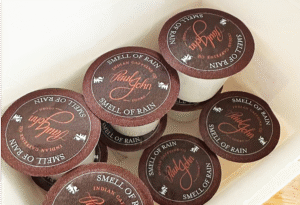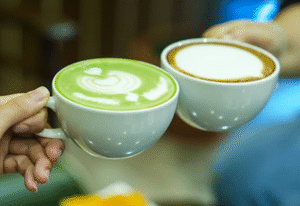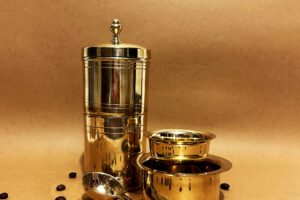
Krueger Cups: Why They’re a Game-Changer for Coffee Lovers
In today’s fast-paced world, convenience is key, especially when it comes to coffee. That’s where K-Cups, also known as Krueger Cups, have changed the game
At Paul John Caffeine, we understand how sacred your morning routine is, it sets the tone for your entire day. Whether you’re a slow sipper or a bold chugger, your cup should be more than just a drink, it should be a ritual. For many, that ritual includes a strong cup of coffee. But in recent years, Matcha has emerged as a trendy alternative with a gentler kick and a host of health benefits. So, what’s really better to start your day with, coffee or matcha?
Let’s brew some clarity together.
We believe that your morning energy drink should not only wake you up, but also nourish your mind and body. Coffee has long been the go-to fuel for many people around the world, including some of the coffee drinkers too, who swear by bold, dark, rich coffee. But matcha tea, a vibrant green powdered tea from Japan, has been gaining popularity for its unique benefits and calm effects.
So let’s break it down sip by sip.
Coffee offers a rich and full-bodied flavor that energizes with one strong kick. At Paul John Caffeine, our beans are shade-grown in Karnataka’s lush estates, delivering intense depth, aroma, and flavor with every brew. Most people drink coffee to boost alertness, increase productivity, and fuel physical performance, all thanks to its high caffeine content.
Coffee’s energy spike is fast but can be intense. Some people love the burst but others experience the jitters or crash. That’s why we recommend pairing your cup with food and staying hydrated to avoid energy dips.
Matcha is made from finely ground green tea leaves and contains a compound called L-theanine, which promotes calm alertness without the spike-crash cycle of coffee. Unlike steeped tea, you consume the entire leaf in powder form, unlocking powerful antioxidants that support metabolism, detoxification, and immunity.
We appreciate how Matcha tea delivers a steady release of energy that keeps you focused and alert for hours. It’s a favorite among yoga practitioners, creative professionals, and those who want mental clarity without overstimulation. The flavor? Earthy and grassy, with a creamy finish when prepared well.
Both Coffee and Matcha contain minimal calories when prepared without sugar, milk, cream or flavoured syrups. A standard cup matcha is prepared by mixing 1 teaspoon of the powder with 2 ounces of hot water, while coffee is typically brewed with hot water. Coffee contains 96 mg of caffeine in a 240 ml cup, while matcha contains 17-44 mg of caffeine per gram, equaling 38-88 mg in a 60 ml cup serving if it’s prepared in a standard way. Both these beverages have a bitter taste.
Both coffee and matcha are known for multiple health benefits. Below are some of the benefits they offer.
Both matcha and coffee may aid weight loss by boosting metabolism and activating brown fat, which burns calories and fat. Their antioxidants—CGA in coffee and EGCG in matcha—further help reduce fat storage and improve metabolism.
Antioxidants like EGCG in matcha and CGA in coffee help combat oxidative stress, potentially reducing the risk of cancers and chronic diseases. Matcha also contains vitamin C, rutin, and chlorophyll, while coffee offers cafestol and kahweol—each contributing additional protective antioxidant effects.
Polyphenols in matcha and coffee may support heart health by reducing blood pressure, cholesterol, and preventing artery blockage. However, while matcha’s EGCG offers clear benefits, unfiltered coffee’s cafestol and kahweol may raise LDL cholesterol and triglyceride levels.
We at Paul John Caffeine believe your choice depends on your lifestyle, health goals, and taste preferences.
And here’s the fun part, you don’t have to pick just one. You can rotate between both. Coffee for busy weekdays, Matcha tea for slow Sundays. We believe your coffee alternatives should energize you naturally while supporting your overall well-being.
Explore our Karnataka-grown beans like “Monsooned Malabar,” designed for espresso, pour-over, or filter coffee setups. Brew fresh, pair with a light breakfast, and let it ground your intentions.
Whisk one teaspoon of ceremonial-grade Matcha powder into hot (but not boiling) water until frothy. Add a splash of almond milk and honey if desired. Sip slowly, like a meditation in a cup.
Matcha Vs Coffee Both are two popular caffeinated drinks and have their own unique benefits. As your trusted guide to coffee rituals, we encourage you to try both and listen to what your body needs each day. At Paul John Caffeine, we’re not just about selling coffee, we’re here to enrich your everyday experiences. Whether it’s the bold rush of our single-origin coffee or the grounded calm of Matcha, there’s a ritual for everyone.
Matcha might be trendy, but nothing replaces the timeless boldness of Paul John Caffeine coffee. Stick to the classic — order today!

In today’s fast-paced world, convenience is key, especially when it comes to coffee. That’s where K-Cups, also known as Krueger Cups, have changed the game

At Paul John Caffeine, we understand how sacred your morning routine is, it sets the tone for your entire day. Whether you’re a slow sipper

Traditional Indian coffee is brewed using a metal filter that slowly extracts rich, bold flavors over time. Few things match the comforting aroma and rich